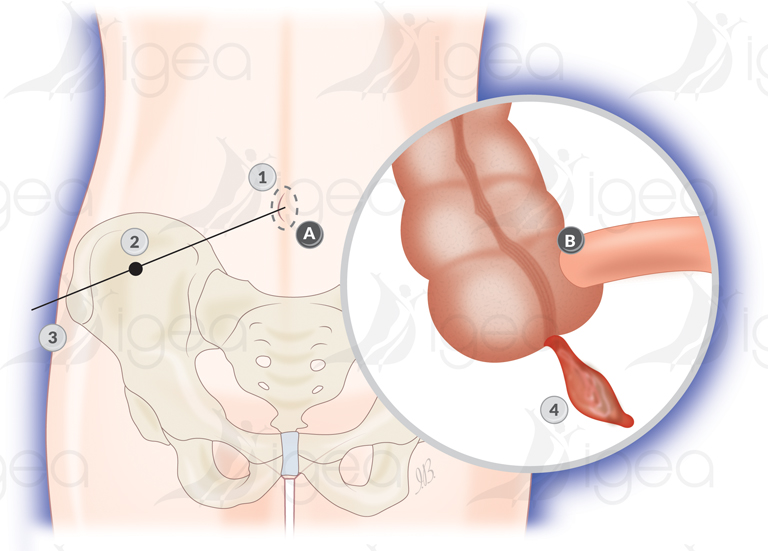Appendectomy

Definition
Appendicitis is the pathological inflammation of your appendix ileocaecal.
The appendix is situated at the base of the caecum, meaning at the bottom right of the abdomen, but its length and position may vary. It can move up towards the liver, move towards the back (retrocaecal) or even move towards the middle of the stomach.
The pain of an appendicitis may typically spread, generally starting around the navel and then moving towards the right iliac fossa. The intensity of the pain generally increases over a period of 12 to 18 hours.
This pain in the right iliac fossa, at the bottom right of the stomach, may also be accompanied by a fever (around 38°C), nausea, and vomiting.
Appendicitis can occur at any age, but more frequently before the age of 30.
The standard treatment is the surgical removal of the appendix.
The appendectomy is the most frequent urgent surgical treatment
Symptoms
The diagnosis of appendicitis is based on the questions asked of the patient at the clinic.
Signs and symptoms of appendicitis:
- Pain
- The pain starts around the navel, then moves towards the right iliac fossa.
- The pain gets worse if you cough, walk, or make other movements.
- The pain can move to your back. Tenderness to palpitation when pressure is applied on the right side of the abdomen.
- The pain may vary depending on the position of the appendix, and the disposition and specificities of the patient.
- Young children and pregnant women, in particular may have appendicitis pain in different parts of the abdomen.
- Serious symptoms
- Positive Blumberg’s sign: Significant pain upon removal of pressure, which happens when you apply pressure with your hand on the right iliac fossa and then suddenly remove the pressure.
- Other Symptoms
- Fever
- Loss of appetite
- Nausea, Vomiting.
- Total shutdown of gases.
- Constipation / Diarrhoea.
You must make an appointment to see your GP/Family Doctor if you have signs or symptoms which worry you.
Any abdominal pain which is so intense that it stops you sitting down or finding a comfortable position, requires immediate medical attention.
Appendicitis may cause some serious complications: A perforation of the appendix may cause an abscess or a peritonitis, an infection of the inner lining of your abdomen.
Complementary diagnosis
Sometimes the history of your signs and symptoms and an in-depth examination of your abdomen, might not be sufficiently conclusive to diagnose an appendicitis.
Before an appendectomy takes pace, further examinations are necessary.
Please note:
- Biological examination (blood sample).
- A blood analysis may show an inflammatory syndrome with a high rate of white blood cells (hyperleukocytosis) and C-reactive protein (CRP).
- Sometimes an echography or a CT scan, can confirm the existence of an appendicitis and exclude all other potential causes of pain.
- Imaging techniques
Surgical treatment
This treatment generally implies a form of surgical procedure, called an appendectomy, where the inflamed appendix is removed.
The appendectomy is carried out either by a minimally invasive procedure (coelioscopy / keyhole surgery – laparoscopy) or by open surgery with an abdominal incision of 3-6 centimetres.
The appendectomy by keyhole surgery involves 2 small incisions in the skin (3mm or 5 mm ) plus an incision for the camera (10mm).
The appendix is dissected and removed by special instruments under video control.
In general, keyhole surgery allows you to recover more quickly and has an aesthetic advantage, with limited, small scars.
But keyhole surgery is not possible in every case.
If the infection has spread, if an abscess has appeared, an appendectomy by open surgery may be necessary to clean the abdominal cavity.
Depending on your situation, a long course of medical antibiotics may be necessary: an old infection with partitioning of the caecal region (appendicular lump), the presence of an appendicular lump.
A treatment of antibiotics can be associated to a radiological drainage of a possible collection, by placing a surgical drain tube passed through the skin, and an eventual appendectomy at a later date (a few weeks later after the infection has been controlled).
Convalescence after an appendectomy takes place
If your appendicitis is serious – associated appendicular abscess, generalised peritonitis – more time is needed to recuperate.
If you have had an open surgery appendectomy, you must limit activity for the first 10 to 14 days after surgery.
If your appendectomy was carried out by keyhole surgery (laparoscopy) with a coelioscopy, you must limit your activity after the surgery to only the first 5 days.
- At the beginning, avoid any intense physical activity.
- Do no sports for two to four weeks after surgery.
- Start with walks, then slowly increase your activity.
- Compress your abdomen when you cough. You may feel some pain when you cough, laugh, or with other movements.
- You can go back to work if you feel up to it.
- Ask your GP/Family doctor when you can resume normal activities.
- Call your GP/Family doctor if your pain killer medicines are not efficient.
Appendectomy Complications
General complications (linked to all abdominal surgery):
- Thrombosis.
- Pulmonary embolism.
- Haemorrhage.
- An infection at the site of the incision, the urinary catheter, intravenous line.
- Occlusion of an Intraperitoneal catheter
Conversion of a keyhole surgery (laparoscopy) into conventional surgery:
- Rare (local adjustments, adherence, technical problem, generalised peritonitis)
Persistence of an infection in the abdominal cavity:
- The formation of a deep abscess may require complementary radiological and surgical treatment.
Riferimenti bibliografici
- Reference 1 : Test1
- Reference 2 : Test
- Reference 3 : Test
- Reference 4 : Test
- Reference 5 : Test
- Reference 6 : Test
- Reference 7 : Test
- Reference 8 : Test
- Reference 9 : Test


